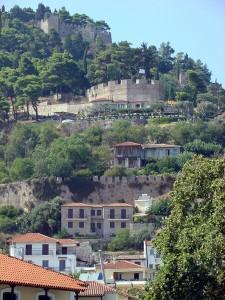Nafpaktos History
The name of Nafpaktos, also spelled Naupactos or Naupactus, is a compound word from nafs (naus=ship, compare to "nautical") and the verb pegnimi=build, a form of which is pakt or pact (compare to compact). So Nafpaktos actually means "where ships are built"!

Nafpaktos, built in a key post communication junction between the Peloponnese and Sterea Hellas, had a simultaneous control over the western gateway to the Corinthian Bay. Its strategic position for the defense of Etolia and its role as an in-between station for the west Europeans to the Holy Land, promoted it to one of the most important medieval ports in the Greek area.
During the early Byzantine period, the information about Nafpaktos is limited to its ecclesiastical status. The first report about a bishop of Nafpaktos is related to Martyrios, who participated in the Sardiki-Sofia Synod in 343 A.D. The historian, Procopius, mentions the city castle in the 6th century.
In the Middle Byzantine period, the information drawn from texts about Nafpaktos refers to much more. During the 8th and the 9th centuries, the city would suffer several Slavic raids. After 899, it constitutes a main part of the Nicopolis Thema. In the early 10th century, Nafpaktos becomes the Thema capital and a Metropolis seat as well. It is also one of the most important ports for the Byzantine fleet, an in-between station for diplomatic contacts with the West, and, in parallel, it is connected with Constantinople by road.
After 1204, Nafpaktos goes under the control of the Venetians, being recorded as “Nepanto” or “Lepanto” in Venetian documents. By the Treaty of 1210, it is ceded to Michael A’ Angelos Dukas Komnenos, the founder of the so-called Despotate of Epirus. In 1294, Nikephoros I Dukas Komnenos, despot of Epirus, offers Nafpaktos as a marriage portion to Philip A’ of Taras (Taranto) on his marriage with his daughter, Thamar Angela Komnene Dukaina. After 1320, the city was under Andegavian control, and, in 1361, Albanians became its sovereigns. During the last decades of the 14th century, Albanians, Venetians and Ottomans were fighting for its occupation. In 1407, Nafpaktos goes under Venetian Dominion. Venetians, in their attempt to create a safe commercial station, repaired the Byzantine walls and fortified the port. Finally, the Ottomans took possession of the city in 1499. Nafpaktos was liberated in 1829 and incorporated into the newly established Greek State.
|
|



